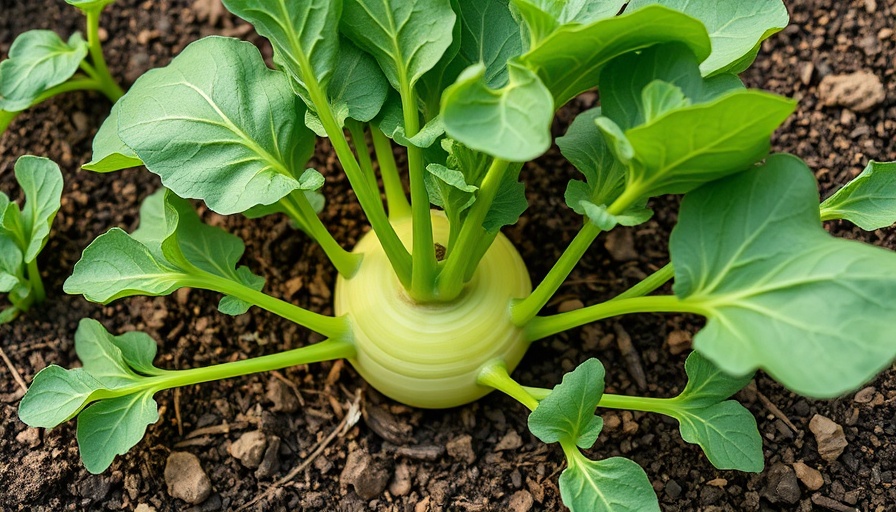
Understanding Kohlrabi: A Unique Vegetable Worth Growing
Kohlrabi, also known as cabbage turnip, is not only a versatile vegetable but also a fun addition to any home garden. If you’ve ever struggled to find them at a supermarket, you’re not alone; these quirky veggies have developed quite a fanbase for their distinct flavor and texture. They offer all the benefits of traditional brassicas, combined with a crisp, refreshing taste that’s perfect for salads, stir-fries, and even raw snacking. With just a little attention to planting density, kohlrabi can thrive in the most enthusiastic underground gardens.
Optimal Plant Spacing: Essential for Plant Health
To ensure that your kohlrabi grows optimally, proper spacing is key. Each plant needs room to develop its bulbous stem. This becomes especially critical when considering their unique growing habits—their need for both roots and foliage to flourish without crowding one another. When planting seedlings indoors, it’s a good practice to space them about four inches apart. This allows the excellent airflow needed to combat common pests and diseases while giving each plant a chance to develop its full flavor.
Row Spacing: A Crucial Component in Sustainable Gardening
If you're cultivating kohlrabi in rows, a spacing of four inches between each plant and a distance of 12 to 18 inches between rows is recommended. This configuration not only maximizes your garden space but also enhances accessibility for maintenance and harvesting. Having room to maneuver is vital, especially for urban gardeners who often utilize smaller plots. Maintaining these measurements will keep plants healthy and prevent overcrowding, which can lead to distorted growth and poor yields. Moreover, urban gardening spaces must be well planned to allow efficient use of limited areas.
Square Foot Gardening: A Space-Efficient Strategy
For those opting for a square foot gardening approach, placing nine plants per one-foot grid section can yield great results. Here, plants should also be spaced four inches apart. The square foot method is often celebrated for its efficient use of space, making it a popular choice among urban gardeners who seek a balance between quantity and diversity in their crops.
Benefits of Growing Your Own: A Journey Towards Self-Sufficiency
Besides providing delicious homegrown produce, nurturing your vegetable garden can significantly enhance your mental well-being. Research shows that engaging with nature—like tending to your vegetable patch—can reduce stress and foster a sense of accomplishment. Packing your garden with kohlrabi not only supports your diet with healthy choices but also turns your gardening endeavor into a rewarding experience, nudging you towards a lifestyle of sustainable living and self-sufficiency.
Common Misconceptions: What You Might Not Know About Kohlrabi
Many new gardeners mistakenly believe that traditional row gardening is the only way to produce vegetables effectively. However, by employing techniques like square foot gardening, you can achieve optimal growth while keeping your garden compact and manageable. Kohlrabi is particularly forgiving with its growth requirements, making it an excellent choice for newcomers eager to jump into gardening.
Frequently Asked Questions About Kohlrabi Gardening
As you embark on your kohlrabi growing journey, you might have questions. How do I know when to harvest? What pests should I watch out for? These queries reflect common concerns. Generally, kohlrabi can be harvested when the bulbs are around 3-4 inches in diameter. During your gardening foray, be vigilant of pests common to brassica family members, such as aphids and cabbage worms, by implementing companion planting strategies.
Ready to Transform Your Garden with Kohlrabi?
Now that you have a clearer understanding of how far apart to space your kohlrabi plants and the vital care they need, it’s time to get growing! Embracing a gardening endeavor like this not only contributes to healthier eating but opens the door for communal sharing and the joy of cultivating your very own food supply. If you’re interested in learning more about different kohlrabi varieties, or perhaps methods to protect your plants from pests, our resource section is filled with practical advice for aspiring gardeners. Let’s get planting!
 Add Row
Add Row  Add
Add 




 Add Row
Add Row  Add
Add 

Write A Comment